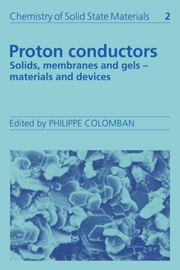Book contents
- Frontmatter
- Contents
- List of contributors
- Preface
- Symbols
- I HYDROGEN BOND AND PROTONIC SPECIES
- II MATERIALS: PREPARATION, STRUCTURES AND PROPERTIES
- III PROTON DYNAMICS AND CHARGE TRANSPORT
- IV PROTON DIFFUSION MECHANISMS
- 29 Mobility in hydrogen-containing oxide bronzes: the atomic-level detail
- 30 Conductivity mechanisms and models in anhydrous protonic conductors
- 31 Conduction mechanisms in materials with volatile molecules
- V DEVICES
- Index
29 - Mobility in hydrogen-containing oxide bronzes: the atomic-level detail
Published online by Cambridge University Press: 04 May 2010
- Frontmatter
- Contents
- List of contributors
- Preface
- Symbols
- I HYDROGEN BOND AND PROTONIC SPECIES
- II MATERIALS: PREPARATION, STRUCTURES AND PROPERTIES
- III PROTON DYNAMICS AND CHARGE TRANSPORT
- IV PROTON DIFFUSION MECHANISMS
- 29 Mobility in hydrogen-containing oxide bronzes: the atomic-level detail
- 30 Conductivity mechanisms and models in anhydrous protonic conductors
- 31 Conduction mechanisms in materials with volatile molecules
- V DEVICES
- Index
Summary
Mobility of H-atoms in hydrogen oxide bronzes and related systems has excited considerable interest in view of their possible applications in e.g. catalysis and electrochromic electrodes for display devices. In practical materials the structure of the host oxide may be ill-defined and intercrystallite regions may contribute significantly to observed (bulk) mobilities. This article aims to present a consistent picture (derived from the published work of many scientists internationally) of the atomic level phenomena responsible for intracrystallite H-atom mobility in wellcharacterized single phases. The detailed characterization of such phases is discussed by Dickens & Chippindale (Chapter 7).
Applicable techniques
The primary techniques used in probing the atomic level detail of motions of protonic species in hydrogenous oxide bronzes are (a) nuclear magnetic resonance and (b) quasielastic scattering of neutrons. The particular applicability of these techniques arises from the high gyromagnetic ratio (and consequent high sensitivity in NMR) and high cross-section for the incoherent scattering of neutrons (emphasizing motions of protonic species when protons are present) characteristic of the nucleus. There are a number of conditions to be met in order that the interpretation of the results of such measurements should be reliable and unambiguous. Ideally these include (i) rigorous chemical characterization of the materials under investigation, (ii) a self-consistent and chemically sensible interpretation of the results of measurements using each technique, (iii) in relationship of the results of several techniques on near-identical samples and (iv) testing of the complete multi-technique set of results against the predictions of a range of dynamical models.
- Type
- Chapter
- Information
- Proton ConductorsSolids, Membranes and Gels - Materials and Devices, pp. 444 - 456Publisher: Cambridge University PressPrint publication year: 1992



